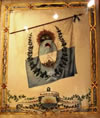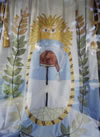
|
Women and Independence in Latin America An exploration of women's involvement in the Latin American Wars of Independence |

|

|
Women and Independence in Latin America An exploration of women's involvement in the Latin American Wars of Independence |

|
Click on one of the images below to see the full-size image
 Bandera de los Andes |
 Fan |
 Flag |
 Ejército de los Andes |
 Plaque |
 Remedios Escalada |
 Remedios Escalada |
 Remedios Escalada |
Gender:Female
Ethnic origen: White
Events:
| 1797 | - | Buenos Aires | - | Not applicable | - | She was born in Buenos Aires on 20 November 1787. |
| 1812 | - | Buenos Aires | - | Unknown | - | She married San Martín on 12 November 1812. |
| 1812 | - | Tucumán | - | Unknown | - | She was living here in 1812. |
| 1814 | - | Mendoza | - | Unknown | - | She joined San Martín in Mendoza |
| 1814-1819 | - | Mendoza | - | Unknown | - | She lived here from 1814-1819. |
| 1815 | - | Mendoza | - | Patriot | - | On 10 October 1815 she gave her jewels to the independence cause. |
| 1816 | - | Mendoza | - | Unknown | - | Her daughter, Mercedes Tomasa was born on 16 August 1816. |
| 1819 | - | Buenos Aires | - | Unknown | - | She returned to her parents' home in Buenos Aires 1819 to 1823. |
| 1822 | - | Buenos Aires | - | Unknown | - | Her father died. |
| 1823 | - | Buenos Aires | - | Unknown | - | She died on 3 August 1823 |
Connections:
Complot de los fusilesBiography:
She was born in 1797 into an upper-class influential family that was unenthusiastic about, but not against, independence. (Halperín-Donghi, 214)
San Martín met her in 1812 when she was aged 14. He married her 8 months later, on 12 November 1812. She was tall, slim, always pale. She died on 3 September 1823, aged 25. (de Soisza Reilly, 46-47)
She married San Martín in 1812 when she was aged 15. They spent some time together during San Martín's life as a military caudillo, in Mendoza and Cuyo. In 1819 Escalada fell ill with tuberculosis and left for Buenos Aires, while San Martin went to Chile. They never saw each other again. In 1823 San Martín returned to Mendoza; he knew that Escalada was too ill to cross the pampa. She died in Buenos Aires in August 1823; San Martín arrived in Buenos Aires in December 1823. On her tomb he inscribed the words: "Aquí yace Remedios Escalada, esposa y amiga del General San Martín". Neuhaus points out that the word "love" was missing, but dismisses rumours of her infidelity. He claims that San Martín did not go to Buenos Aires earlier for fear of capture. (Neuhaus Rizo, 124-127)
She was born in Buenos Aires on 20 November 1787. She married San Martín on 12 November 1812, but stayed in her parents´ house until 1814 when she joined San Martín in Mendoza. On 10 October 1815 she gave all her jewels to the independence cause and encouraged other women to do likewise. Her daughter, Mercedes Tomasa was born on 16 August 1816. In December 1816 she and a group of friends, among them Laurena Ferrari de Olazábal, made a flag for the army. On 24 March 1819, San Martín sent her back to her parents´ house in Buenos Aires as he left to fight battles elsewhere. She was already seriously ill and she died on 3 August 1823. (Sosa de Newton, 210-211)
In 1812 she was among a group of women who sewed uniforms for the patriot army. Several of these offered to buy weapons and they asked that their names be inscribed on them. Their accompanying note (below) was reproduced in the Gaceta Minist, No.12, 26 de junio de 1812. (Mitre, Obras completas, VII, 16-17)
She was born in Buenos Aires on 20 November 1797, the daughter of the Chancellor of the audiencia, Antonio José de Escalada, and Tomasa de la Quintana. She was aged 14 when San Martín returned to Buenos Aires. They married on 12 November 1812 at a private ceremony. Their witnesses were Carlos de Alvear and his wife Carmen Quintanilla. Three months later San Martín left for Upper Peru. She accompanied him to Cuyo where she was welcomed enthusiastically. In 1819 San Martín suggested she return to her parents´ home in Buenos Aires. She was never very healthy and her father's death in 1822 further weakened her. She died on 3 August 1823. Carranza quotes one of her nieces: "She died like a saint, thinking of San Martín who arrived in Buenos Aires some months later, with a heavy heart and a melancholy that never left him." (Carranza, 106-111)
References:
Romero de Valle, Emilia (editor). (1948) Mujeres de América
Carranza, Adolfo P. (1910) Patricias argentinas
Halperín-Donghi, Tulio (1975) Politics Economics and Society in Argentina in the Revolutionary Period
Mitre, Bartolomé (1940) Obras completas de Bartolomé Mitre
Neuhaus Rizo Patrón, Carlos (1997) Las Mariscalas
Sosa de Newton, Lily (1986) Diccionario biográfico de mujeres argentinas